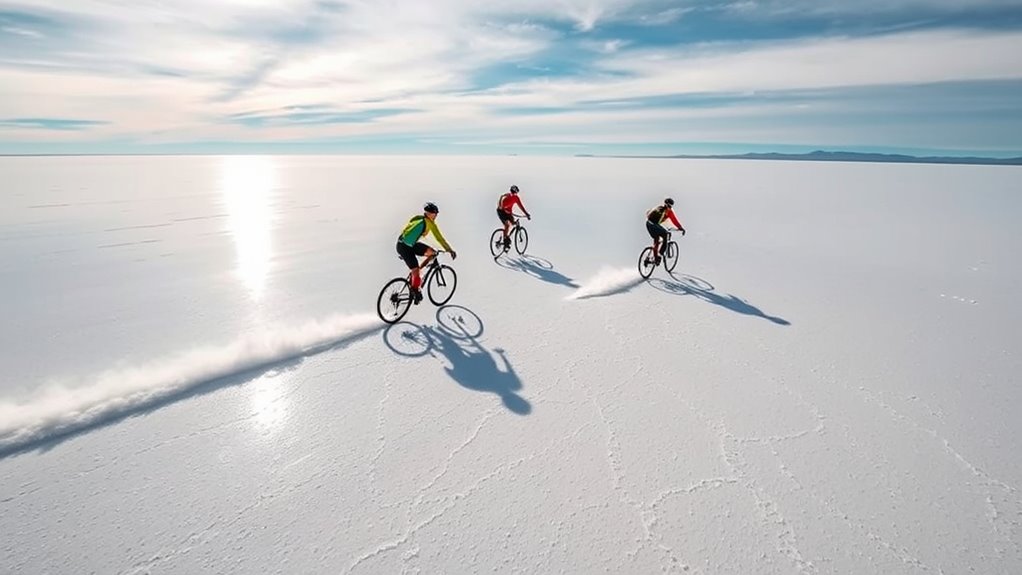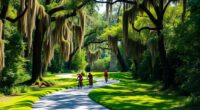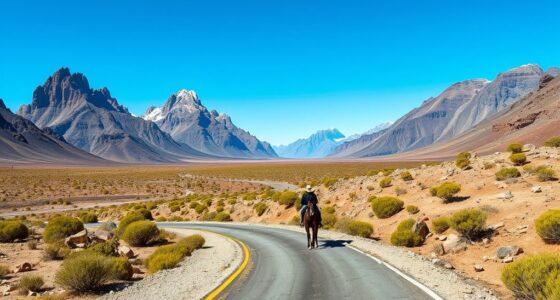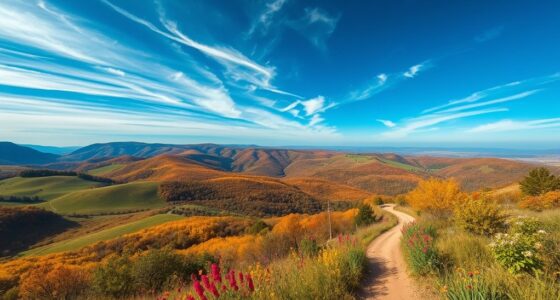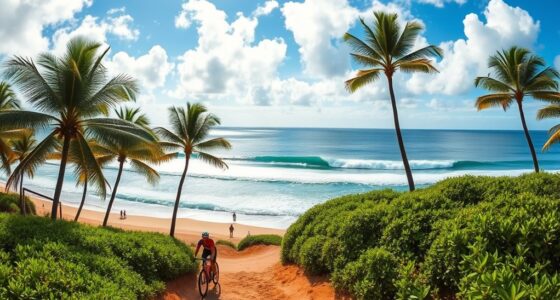Riding Bolivia’s Salar de Uyuni is an unforgettable adventure across the world’s largest salt flat. You’ll encounter stunning landscapes, challenging terrains, and unique cycling experiences. Choose the right gear—fat bikes work best on sandy surfaces while mountain bikes handle varied terrain. Prepare for the unpredictable weather and navigate using a compass. Check out the breathtaking mirror-like reflections during the wet season. There’s much more to discover, like the best time to visit and essential safety tips.
Key Takeaways
- Experience unique terrain on the world’s largest salt flat, with cycling speeds averaging 12-15 km/h across diverse surfaces.
- Choose the right bike, like fat bikes for sandy areas or mountain bikes for varied terrain, ensuring comfort and reliability.
- Prepare for rapidly changing weather, from intense sunlight to sudden storms, and stay hydrated during your ride.
- Capture stunning photographs of mirror-like reflections in the wet season, and explore attractions like Isla Incahuasi and Laguna Colorada.
- Plan your visit between December and April for the best conditions, but be flexible due to potential weather disruptions.
Overview of Salar De Uyuni
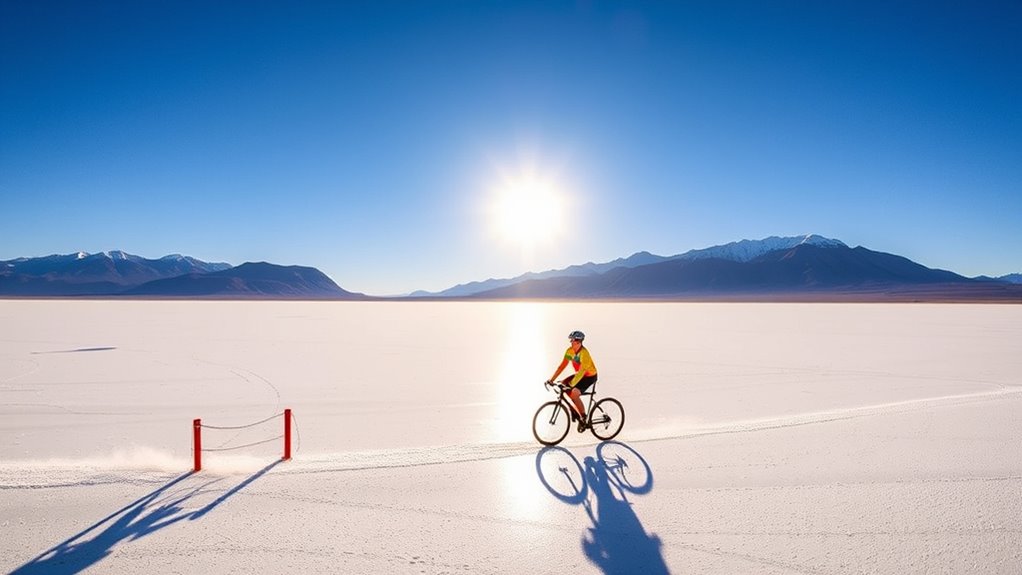
Salar de Uyuni, the world’s largest salt flat, is a breathtaking expanse located in southwest Bolivia’s Daniel Campos Province. Spanning about 10,582 square kilometers, this stunning landscape sits at an elevation of 3,663 meters above sea level.
Formed by the evaporation of ancient lakes, it’s home to unique geological features and rich mineral deposits, including approximately 70% of the world’s lithium reserves. The salt crust varies in thickness from 3 to 10 meters, and the flat’s arid climate creates mesmerizing seasonal changes. High salinity resulted in the evaporation of the prehistoric lake, leaving behind the thick salt crust that defines Salar de Uyuni today.
During the wet season, you’ll witness incredible reflections on the water, while the dry season offers pleasant days and freezing nights. This natural wonder isn’t just beautiful; it’s vital for the region’s economy and ecology.
The Cycling Experience

Cycling across the mesmerizing expanse of Salar de Uyuni offers an unforgettable adventure, as you navigate its unique terrain and breathtaking landscapes. You’ll encounter diverse surfaces, from flat salt tiles to deep grooves and rough bumps, making each pedal stroke a challenge. Expect to average 12-15 km/h, but speed can vary wildly with conditions. Average cycling speed ranges from 6 to 22 kilometers per hour, allowing for a tailored cycling experience based on your fitness level. Navigation is tricky; GPS often fails, so keep a compass handy. The weather can turn harsh quickly, with storms that add excitement to your ride. As you cycle, the surreal scenery of vast white salt and distant rock formations will captivate you.
Choosing the Right Bicycle
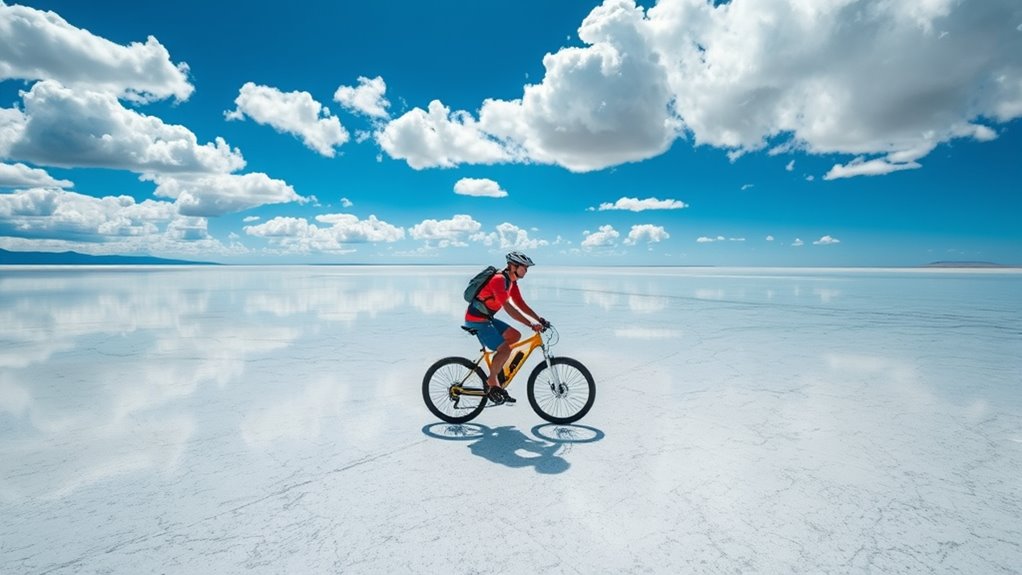
Selecting the right bicycle is crucial for a successful adventure across the Salar de Uyuni. For sandy and corrugated surfaces, fat bikes offer the best support, while mountain bikes excel on varied terrain.
If you plan to cover long distances, consider a touring bike, but be aware they might struggle on sand. A bikepacking setup is essential for carrying your gear. Additionally, remember that the journey across the Salar requires two full days of pedaling, making comfort and reliability vital.
Look for wide, low-pressure tires for stability and traction, along with a durable frame to withstand harsh conditions. Remember to prioritize waterproof gear to protect your essentials.
Lastly, don’t forget to carry tools for repairs and navigation aids like GPS devices and compasses to ensure you stay on track during your ride.
Accommodation and Camping Options
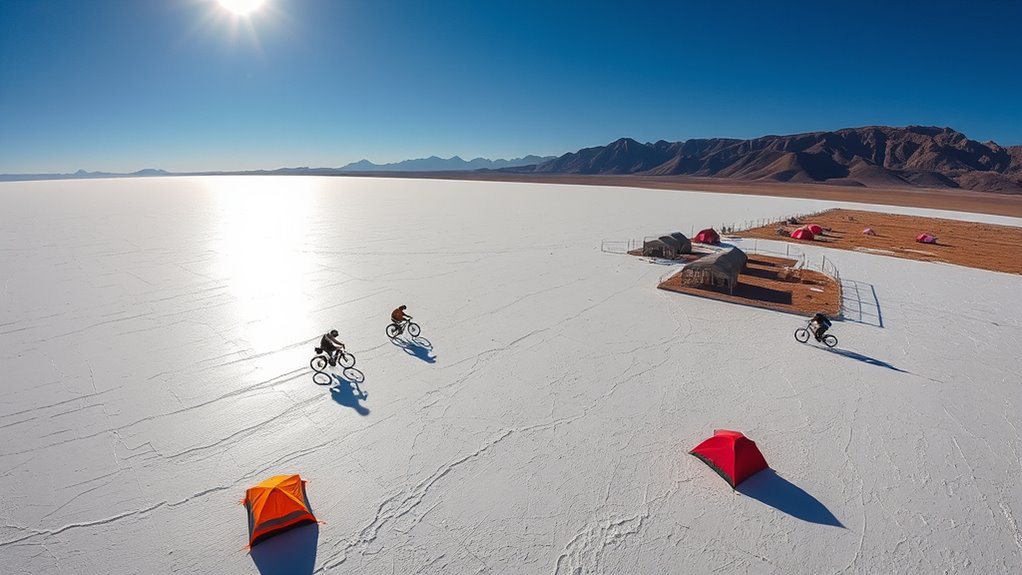
When planning your adventure across the stunning salt flats, you’ll want to consider your accommodation and camping options carefully.
In Uyuni, you can choose from luxury hotels like Palacio de Sal, built entirely from salt, or mid-range options like Hotel Jardines de Uyuni, which offers comfort in the town center. Additionally, there are 43 hotels and other places to stay available in the Uyuni Salt Flats region for various budgets.
For budget travelers, Hostal La Magia de Uyuni provides affordable stays with breakfast included.
If you’re considering camping, be cautious, as there are no permanent facilities on the salt flats. Instead, you might find shelter on Isla Incahuasi with help from the island guard.
Make sure to bring all necessary gear, as preparation is key for a safe and enjoyable experience.
Must-See Attractions
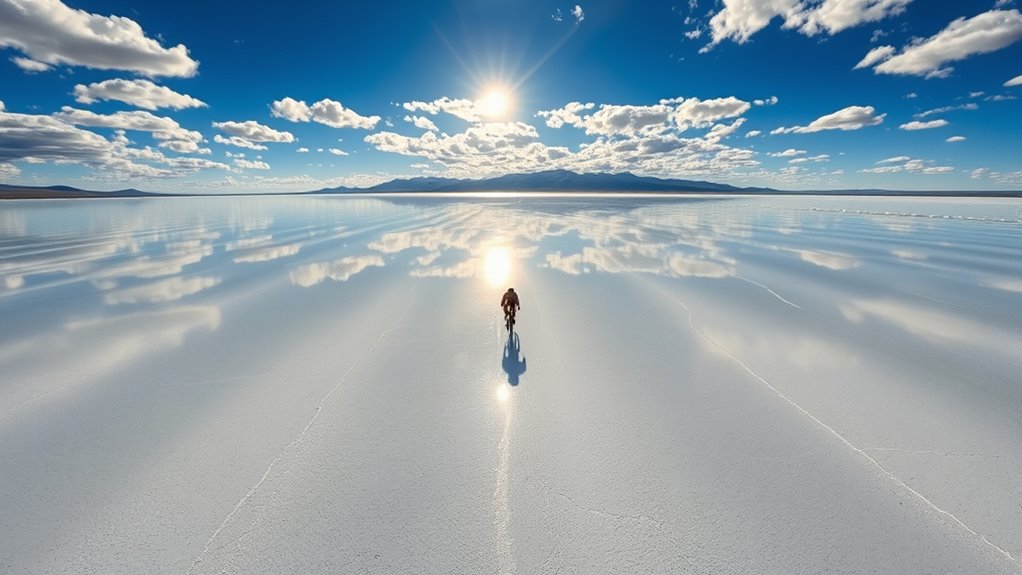
After settling into your accommodation, it’s time to explore the breathtaking sights that Salar de Uyuni has to offer.
Start with the mesmerizing Salar de Uyuni, the world’s largest salt flat, where you’ll witness stunning mirror-like reflections during the wet season.
Next, visit Isla Incahuasi, home to giant cacti and panoramic views that’ll leave you in awe. Be sure to capture the vibrant colors of Laguna Colorada, famous for its reddish hue and rich wildlife, as it’s a short detour from your route.
Don’t miss the Cementerio de Trenes, a haunting train graveyard filled with rusted carriages.
At the Colchani Salt Factory, learn about traditional salt extraction methods.
Lastly, venture to Sol de Mañana, where geysers and bubbling mud pots showcase the geothermal wonders of the region.
Each attraction promises a unique experience that captures the essence of this surreal landscape.
Navigating the Challenges
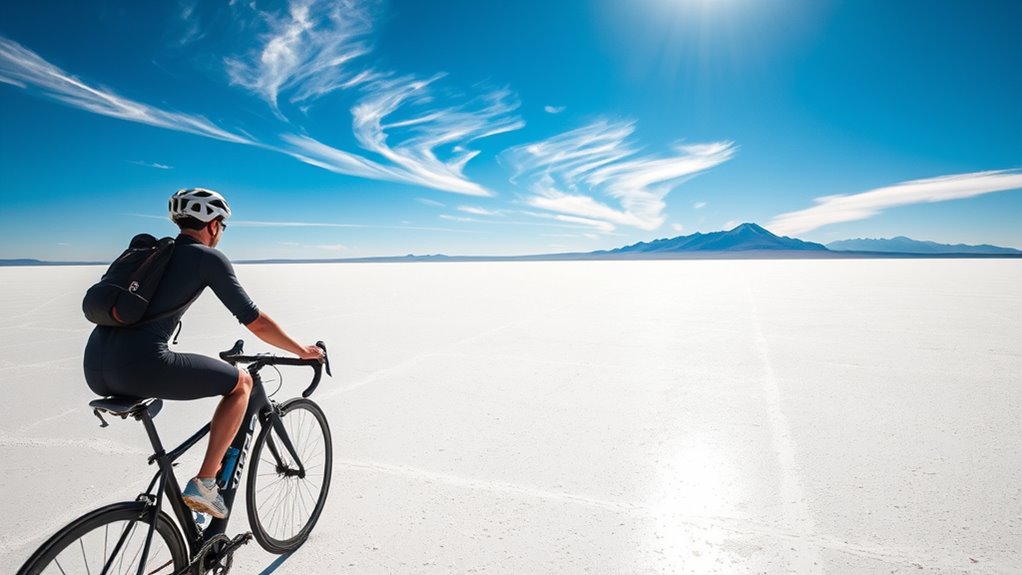
Navigating the vast expanse of Salar de Uyuni can be daunting, especially with its unpredictable surfaces and remote location.
The salt flat’s terrain varies dramatically, featuring flat tiles, deep grooves, and rough bumps that challenge your cycling skills. You’ll need to adapt your bike with low-pressure tires for better grip. Salar de Uyuni‘s breathtaking scenery can make it easy to lose focus on the challenges at hand.
Without clear trails, stick to established car tracks to maintain your direction. GPS devices might fail you, so rely on visual landmarks like Incahuasi Island for orientation.
Stick to established car tracks for navigation, as GPS may falter; use visual landmarks like Incahuasi Island for guidance.
Plan your route in advance to avoid getting lost in the vastness. Be prepared for harsh weather and ensure you’re self-sufficient for breakdowns.
The isolation can be intense, but with proper navigation, you can conquer this unique landscape.
Essential Preparation and Planning
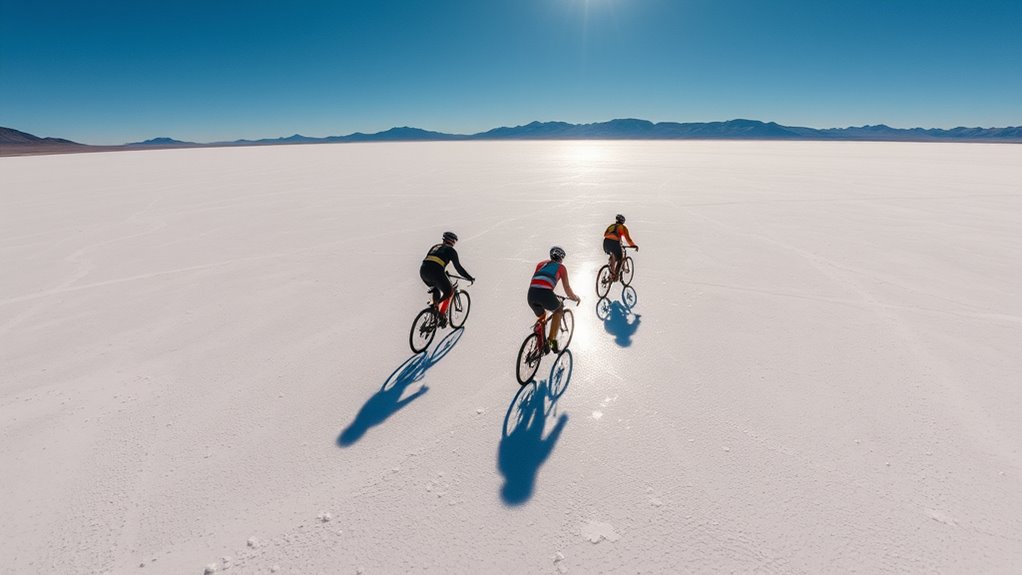
Mastering the challenges of cycling across Salar de Uyuni requires thorough preparation and planning. Start by mapping out your route, choosing between the Salar de Uyuni and Salar de Coipasa. Ensure your bike is in top condition; grease it before riding and wash it afterward to combat salt exposure. Be mindful of the weather, especially during the rainy season when conditions can change rapidly. Equip yourself with a GPS and compass for navigation across the vast, featureless landscape. Carry enough food and water, as supplies are scarce, especially since no public transport is available to the salt flats. Finally, consider your physical conditioning to tackle varying terrains and strong winds. With careful planning, you’ll be ready to embrace the adventure ahead!
Safety Tips for Cyclists
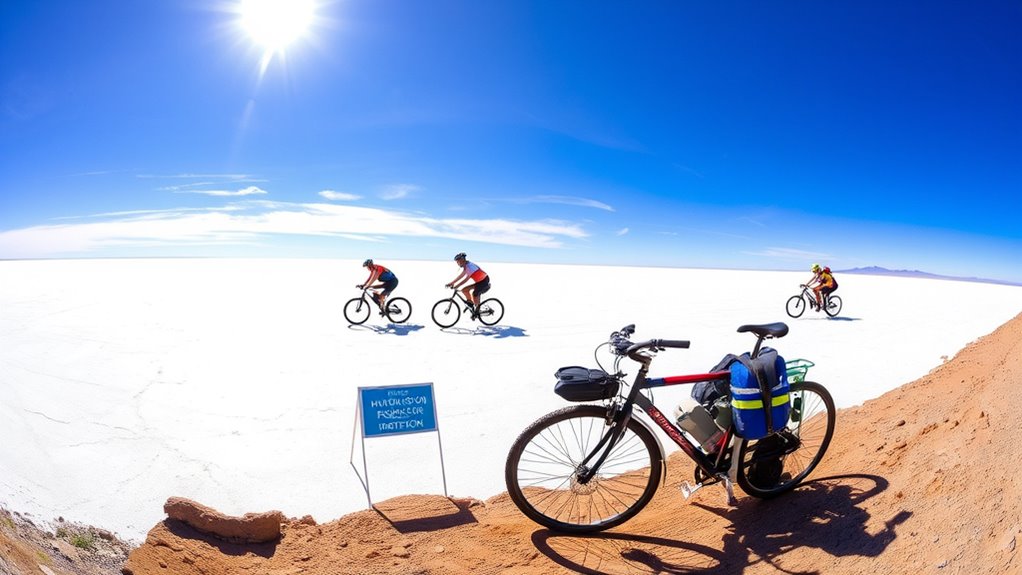
While cycling across the breathtaking Salar de Uyuni, it’s essential to prioritize safety to fully enjoy your adventure.
First, protect yourself from the sun’s harsh rays by applying high-factor sunscreen and wearing quality sunglasses to shield your eyes from UV damage. Strong winds prevalent in the salt flats can also impact your ride, so be prepared for sudden gusts that may challenge your balance while cycling on sandy roads. Additionally, be mindful that indoor air quality can significantly affect your health, especially if you’re cycling in areas with poor air quality.
Equip yourself with reliable navigation tools like GPS and a compass, as the landscape can be disorienting.
Ensure your bicycle is in excellent condition for the varied terrain and carry basic tools for any necessary repairs.
Stay hydrated to combat dehydration and be aware of altitude sickness risks.
Lastly, have a first aid kit handy and a plan for emergencies, including communication devices. Being prepared will help you focus on the stunning surroundings and have an unforgettable ride.
Best Time to Visit and Weather Considerations

If you want to experience the Salar de Uyuni at its best, timing your visit is crucial.
For stunning mirror-like reflections, plan your trip between December and April during the rainy season. However, if you prefer a stark, white landscape, visit from May to November when it’s dry.
Late April offers a unique chance to see both effects while avoiding the peak tourist crowds. Additionally, be sure to explore the breathtaking Salar de Uyuni during your cycling journey, as it is the largest salt flat in the world.
Be prepared for significant temperature drops at night, especially during the dry season, and protect yourself from intense sunlight at high altitudes.
Keep in mind that heavy rainfall can make parts of the salt flat inaccessible, so flexibility in your plans is key to making the most of your cycling adventure.
Frequently Asked Questions
What Permits Are Required for Cycling in Salar De Uyuni?
You don’t need any specific permits for cycling in Salar de Uyuni.
However, it’s crucial to respect the environment and avoid causing damage to the unique salt flats.
While local guides aren’t mandatory, they can be helpful for navigating the vast landscape.
Consider carrying a compass and a GPS device to ensure you stay on track.
Always practice responsible cycling to minimize your impact and enjoy this stunning destination safely.
Are There Any Cultural Etiquette Considerations While Visiting?
When visiting, you should keep cultural etiquette in mind.
Greet everyone in a group individually and embrace local customs with an open mind. Wear modest clothing, especially in rural areas, and respect traditions.
Always ask before taking photos of people, particularly in indigenous communities. If invited to dine, wait for the host to sit first, and be sure to try a bit of everything offered.
Small gifts when visiting homes are appreciated.
Is It Possible to Rent Bicycles Locally?
Yes, you can rent bicycles locally in Uyuni, particularly at the Nativa Hotel.
They offer high-quality mountain bikes along with essential safety gear like helmets.
With flexible booking options, you can easily reserve your bike and cancel up to 24 hours in advance if needed.
Friendly staff provide route suggestions and maps, ensuring you have everything you need for an adventurous ride across the stunning landscapes of the salt flats.
What Food Options Are Available During Cycling Trips?
During your cycling trips, food options are quite limited.
You’ll typically find basic meals like rice, pasta, and potatoes, while quinoa can be a nutritious staple. Occasionally, you might persuade locals to sell you some vegetables.
If you’re self-preparing, setting up a camp kitchen is essential. Remember to carry plenty of water, as access is scarce, and be ready for local hospitality with offerings like quinoa soup when available.
How Do I Handle Emergencies While on the Salt Flats?
When you’re on the salt flats, handling emergencies requires preparation.
If you experience altitude sickness, descend to lower altitudes and rest. Always keep emergency contacts handy—call 118 for medical help.
Protect yourself from UV rays with good sunglasses and be aware of weather conditions. Carry tools for bike repairs, and use a compass to navigate.
Lastly, travel in groups for added safety and support during any emergency situation.
Conclusion
Cycling across Bolivia’s Salar de Uyuni is an unforgettable adventure that’ll push your limits and leave you in awe of nature’s beauty. With the right preparation and a spirit of exploration, you can conquer the vast salt flats while discovering breathtaking sights along the way. Whether you’re camping under the stars or marveling at unique landmarks, this experience will surely create lasting memories. So gear up, embrace the challenges, and enjoy the ride of a lifetime!
